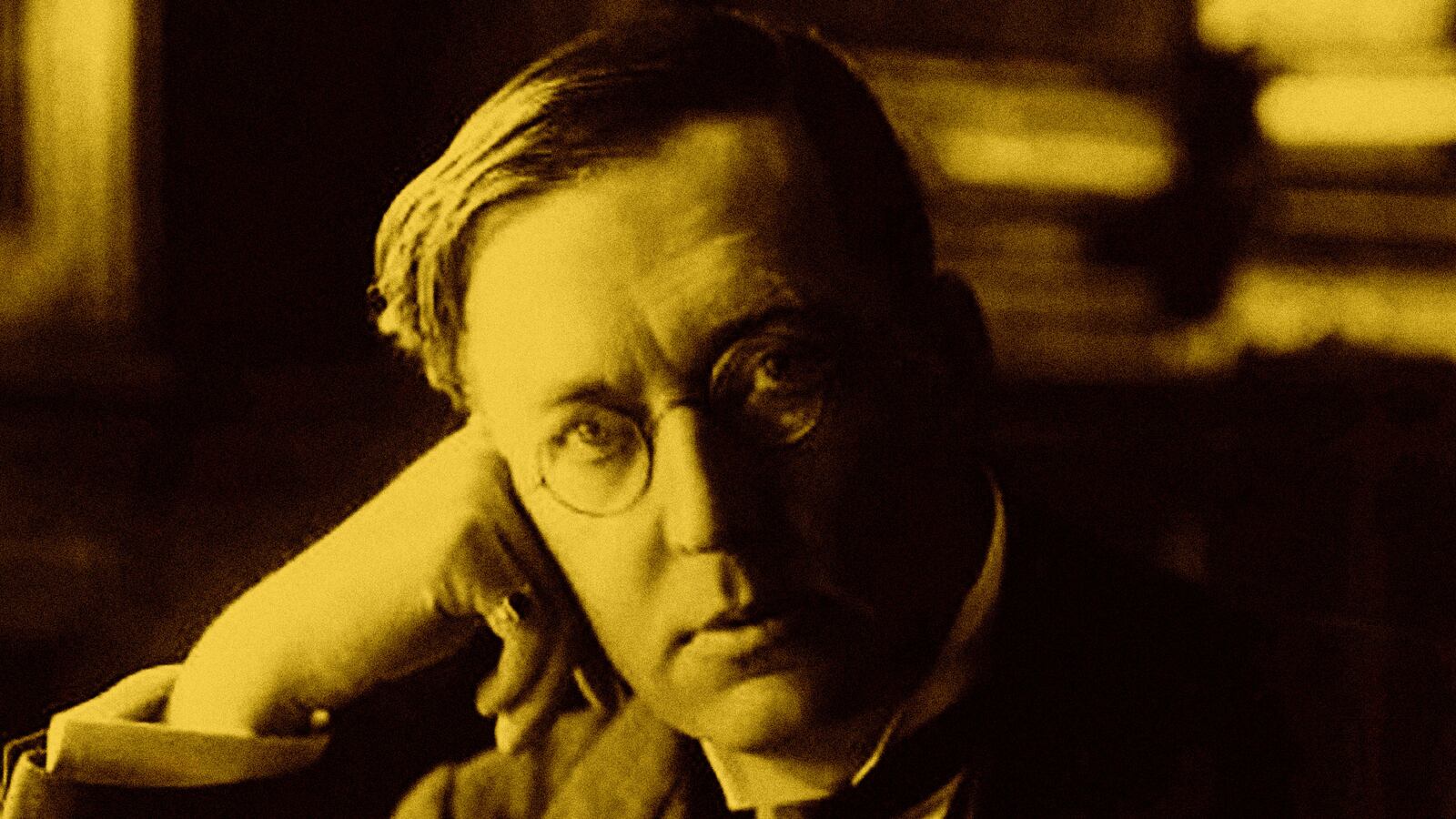Though we never think of Easter as a day pocked by any kind of fear, it’s certainly the holiday that represents the most macabre event out of any of them. Skinny, sage dude, who was trying to revolutionize the world with love, gets his hands and feet nailed to a cross, then spends the afternoon up there until he dies. Upon which, he is stuck in a cave with a rock jammed into its mouth, only to rise from the dead, get out, and find his friends to see if they need to test their belief in him by sticking their fingers in his nail holes. Now let’s eat the crap out of some Peeps and Cadbury Eggs!
Easter is so vernal, with a color scheme of pinks, light blues, and yellows to match, which enlivens everything from little girls’ dresses to ubiquitous Easter eggs. But what has always produced a frisson of fear in me is one of our greatest ghost stories—let’s call it top 20—written by a man who normally reserved his frights for Christmas but saw an opportunity in the soft pastel spring of Easter.
Montague Rhodes James—M.R. to his friends and to us—was born in 1862, living until 1936. He was a scholar and provost, working at a number of universities in England. But it was while he was at King’s College from 1905 to 1918 that he did what he became most famous for.
Each year, at Christmas, James would write a ghost story. These dispensed with the trappings of the spirit yarns of the Victorian age, in favor of more modern sensibilities—an emotionally hidebound, sexually repressed professor taking a holiday and encountering something otherworldly that causes him to confront who he is in this world, for instance. James invited his professor buddies and some favorite students to his rooms on Christmas Eve, and he would then commence to scare them witless. These spectral soirees were legendary.
When I point people to a horror writer, if they’re looking to get into the real good stuff—which is not Stephen King—James is one of my go-to people. But for all of his Christmas jolts, the best ghost story he ever wrote is centered on Easter. We don’t expect to be frightened at Easter, unless an endless parade of Christian iconography gives you the creeps, which I totally get. James must have known that readers—and future readers—would be ripe for petrified plucking when he composed “A Warning to the Curious.”
He was judicious in what he would write and would not pen something unless he was certain he could get it into the gem-like fashion he favored. Still, “A Warning” is as close as he got to the perfect ghost story. It is the time of the Easter Moon—which, for this story, is a bit like Echo and the Bunnymen’s “Killing Moon”—and two buddies are having a golfing holiday together in an English coastal town. The narrator buddy remarks that his golfing buddy is dead—for it is many years later—so he can’t corroborate what happened here, but he’s got a tale to tell.
The story begins with more than a page of description and scene-setting. James does this nowhere else in his canon of 30 or so stories. “Well, at the top of my little hill, a line of these firs strikes out and runs towards the sea, for there is a ridge that goes that way; and the ridge ends in a rather well-defined mound commanding the level fields of rough grass, and a little knot of fir tree crowns it. And here you may sit on a hot spring day, very well content to look at blue sea, white windmills, red cottages, bright green grass, church tower, and distant Martello tower on the south.”
These aren’t old guys on a golfing holiday. They feel about 26. They’re staying at a place which is like a dorm for adults. Old school style. You’re not supposed to be out super late. Maybe that made it cheaper. I don’t know. They’re not rich guys, but they’re certainly good guys, fair guys. And one night, as the friends sat in the lounge, one of them, Long—the man we know is dead—is playing solitaire, the narrator is writing, when a third man named Paxton joins them.
This is a story where we must note the configurations of numbers. Easter Moon out in the sky, three fellows coming together. Paxton hangs for a bit, but he’s fidgeting, and he is prevailed upon by the other two to unburden himself. Until this point, we’ve felt cozy. James pulled us in with that description, which all but produced the smell of brine and newly-dewed grass in our nostrils. We’ve felt as if we were in this room by the fire having a nice lounging session, and now that we are fully immersed, something is going to happen.
Paxton begins by asking if the two friends are aware of the legend of the three crowns. A second trinity, then. They are, but James is going to signpost this road for us and walk us down it. The legend was that three royal crowns were buried at strategic beachheads in England, to ward off invaders. To weaken them, confuse them, scatter them. One family took it upon itself to guard one of the burial spots. They did this through the generations. The last guardian was a sickly young man in his late twenties, who nonetheless camped out at night in cold and rain, guarding the crown, until he died before his time in his devotion. Paxton, who is relocating to Sweden and has a couple weeks to kill, has an easy time of learning, from simple townsfolk, where this man stationed himself, and with no remarkable effort, he dug up the crown. He also dug up something of a problem.
A delicious idea, right? Sometimes you have an idea as a writer where you think, “Wait, that’s almost too perfect, did someone hit on this before?” Not unlike what happened with Paul McCartney when the melody to “Yesterday” came to him. This was one of the best ideas of James’ compact ghost story-writing career. The two friends are stoked—they are going to see a real deal Anglo-Saxon crown. “But our man gazed at us with a rueful eye,” the narrator plaintively informs us. “’Yes, he said, ‘and the worst of it is I don’t know how to put it back.”
That is the plot’s mechanism—the restoration—the re-interring/re-tombing—of the vaunted symbol that has been made visual and manifest. We are playing off of a New Testament conceit—entombed human-saving king—with Old Testament fury, for Paxton is being followed by something, though he is not sure exactly what. Which is rather worse. The friends and Paxton inspect the crown in the latter’s room. He’s careful not to let their skin come in direct contact with it. That’s very important to him. Regarding what it is following him, he expresses the beyond-creepy, pithy line that it seems to have some control of your eyes. He’s like a student coming to learn a lesson, and his first foothold in that lesson is already sufficiently terrifying in its fullness of knowledge that there is greater, unremittable fear for what must be waiting to come.
Before courage fades in the cold light of deliberation, the three agree to a plan. They will make some excuse to leave the venue they are staying at that night—it’s like you need permission from an RA—and return the crown to its barrow. As the two friends go off to get ready, Paxton asks them to make sure that the hallway coast is clear. It’s those unexpected details that make James so Jamesian. They provide the fillip—that powerful flick of nerves—to your heart. They have no problem finding the clearing in the bower by the sea where the crown had been laid. The friends stand back as Paxton works swiftly, like he’s some master archeologist going in reverse. He packs down the earth with great care after, then ushers his new friends away with celerity. That duo looks over their shoulders to see that Paxton has left his dark coat behind, and it appears to be propped up on something. “Yet, in all this quiet, an acute, an acrid consciousness of a restrained hostility very near us, like a dog on a leash that might be let go at any moment,” has been felt, and so it is both with no surprise and legitimate surprise—again, exceedingly Jamesian—that Paxton, not bothering to turn around to look, remarks that that is not his coat.
The next day, “on as beautiful an April morning as you could desire,” the two friends find Paxton in slightly better spirits. They are off to play a game of golf, and say they will reconnect with him after. They return from their outing to learn that Paxton just went out and seemed to be following them. The friends, naturally, don’t understand this at all, in one way, but in another, they do.
On a shingle high above the sea, they race, seeing Paxton below, running to catch up with what they realize Paxton thinks is them. He catches up with something. When the friends descend down to find his corpse, they see that his mouth is rammed with sand and broken bits of seashell. They’re fortunate that a nearby caretaker had witnessed everything and comes running to help, or else they’d be accused of murder.
There’s a cool reading by Michael Hordern—the actor who played Jacob Marley in 1951’s Scrooge—that is excellent, plus a BBC short film adaptation worth screening. But there is nothing like leaning over the pages of this story, eyes traveling along the shapes of sentences like those of the friends looking down on the racing Paxton below, to remind us of powers beyond ourselves. James has them go the way of darkness rather than light. It’s like what Easter might have been, minus a resurrection. Or, maybe, a different kind of resurrection. Hide those eggs well.







